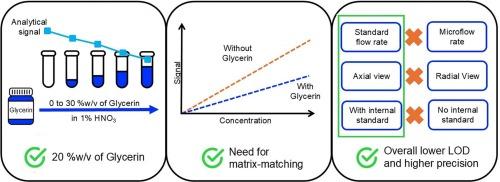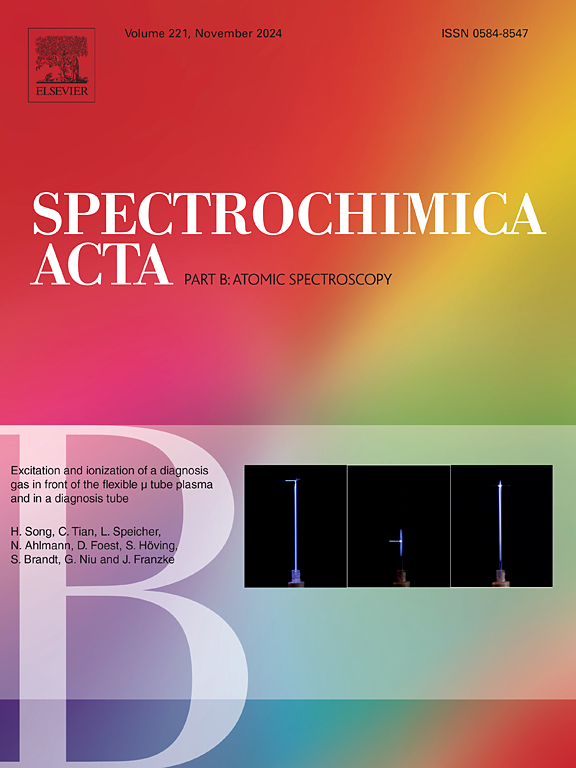ICP OES稀释射击甘油样品时标准流速与微样流速的分析比较
IF 3.8
2区 化学
Q1 SPECTROSCOPY
引用次数: 0
摘要
本研究采用电感耦合等离子体发射光谱法(ICP-OES)系统地研究了标准样品和微样品的流速(使用相同的雾化器),以“稀释射击”法测定甘油样品中的As、Ca、Cu、K、Mg、Na、P、Pb和Zn。甘油的存在影响ICP-OES横向和轴向的元素测定;无论样品流速如何,内部标准都无法纠正干扰。测定甘油样品中痕量元素的最佳仪器条件选择为:将甘油样品在HNO3 0.14 mol L−1中简单稀释,然后进行基质匹配校准,以Sc为内标。检出限分别为0.1 (As)、0.03 (Ca)、0.007 (Cu)、0.005 (K)、0.003 (Mg)、0.004 (Na)、0.2 (P)、0.1 (Pb)和0.01 (Zn) μg−1,多数分析物的短期精密度低于2.0%。对三种商品甘油样品进行了分析,该方法为准确定量甘油中的杂质提供了稳健可靠的方法,确保了法规的合规性和各种工业应用的适用性。本文章由计算机程序翻译,如有差异,请以英文原文为准。

Analytical comparison between standard and micro sample flow rate for the dilute-and-shoot analysis of glycerin samples by ICP OES
In this study, standard and micro sample flow rates (using the same nebulizer) were systematically investigated for the “dilute-and-shoot” determination of As, Ca, Cu, K, Mg, Na, P, Pb, and Zn in glycerin samples using inductively coupled plasma optical emission spectrometry (ICP-OES). The presence of glycerin affected the element determination by ICP-OES using lateral and axial views; the interferences could not be corrected with internal standards, regardless of the sample flow rates. The best selection of instrumental conditions for the trace-element determination in glycerin samples involved simple dilution of glycerin samples in HNO3 0.14 mol L−1, followed by matrix-matching calibration and using Sc as an internal standard. The limits of detection were, in μg g−1, 0.1 (As), 0.03 (Ca), 0.007 (Cu), 0.005 (K), 0.003 (Mg), 0.004 (Na), 0.2 (P), 0.1 (Pb) and 0.01 (Zn), while the short-term precision was lower 2.0 % for most analytes. Three samples of commercial glycerin were analyzed, and the method provided a robust and reliable approach for accurately quantifying impurities in glycerin, ensuring regulatory compliance and suitability for various industrial applications.
求助全文
通过发布文献求助,成功后即可免费获取论文全文。
去求助
来源期刊
CiteScore
6.10
自引率
12.10%
发文量
173
审稿时长
81 days
期刊介绍:
Spectrochimica Acta Part B: Atomic Spectroscopy, is intended for the rapid publication of both original work and reviews in the following fields:
Atomic Emission (AES), Atomic Absorption (AAS) and Atomic Fluorescence (AFS) spectroscopy;
Mass Spectrometry (MS) for inorganic analysis covering Spark Source (SS-MS), Inductively Coupled Plasma (ICP-MS), Glow Discharge (GD-MS), and Secondary Ion Mass Spectrometry (SIMS).
Laser induced atomic spectroscopy for inorganic analysis, including non-linear optical laser spectroscopy, covering Laser Enhanced Ionization (LEI), Laser Induced Fluorescence (LIF), Resonance Ionization Spectroscopy (RIS) and Resonance Ionization Mass Spectrometry (RIMS); Laser Induced Breakdown Spectroscopy (LIBS); Cavity Ringdown Spectroscopy (CRDS), Laser Ablation Inductively Coupled Plasma Atomic Emission Spectroscopy (LA-ICP-AES) and Laser Ablation Inductively Coupled Plasma Mass Spectrometry (LA-ICP-MS).
X-ray spectrometry, X-ray Optics and Microanalysis, including X-ray fluorescence spectrometry (XRF) and related techniques, in particular Total-reflection X-ray Fluorescence Spectrometry (TXRF), and Synchrotron Radiation-excited Total reflection XRF (SR-TXRF).
Manuscripts dealing with (i) fundamentals, (ii) methodology development, (iii)instrumentation, and (iv) applications, can be submitted for publication.

 求助内容:
求助内容: 应助结果提醒方式:
应助结果提醒方式:


